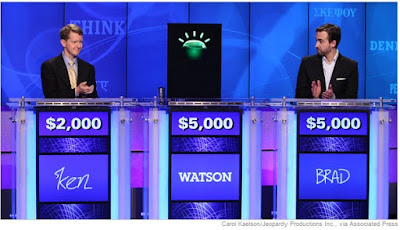Twitter Feed
Transformation Network
The Achilles heel of every transformative business model is their reliance on ever increasing amounts of data that need to be transported quickly across wide area networks and processed at…
Essential Characteristics of Cloud Computing as Digital Transformation
Hybrid IT blends traditional datacenters, managed service providers, and cloud service providers to deliver the necessary mix of information technology services. This IT consumption model enables a composable infrastructure which…
Transformation Innovation
4 Factors Driving Digital Transformation ROI The critical assessment factors for cloud ROI risk probability are the following: Infrastructure utilization Speed of migration to cloud Ability to scale business/mission processes…
Transformation Frameworks
Digital transformation necessitates changes in an organization’s operational processes. According to Harvard, a focus on operations can lead to business process optimization and entirely new revenue streams. Three common routes…
Transformation Infrastructure
Hybrid IT enables a composable infrastructure which describes a framework whose physical compute, storage, and network fabric resources are treated as services. Resources are logically pooled so that administrators need…
Essential Characteristics of Cloud Computing as Digital Transformation
A survey of 2,000 executives conducted by Cognizant in 2016 identified the top five ways digital transformations generate value: Accelerating speed to market Strengthening competitive positioning Boosting revenue growth Raising…
Embrace Transformation
From a business perspective, differentiating business processes and quality customer service are central to overall success. Business leaders must therefore clearly identify and measure how information technology contributes to the…
Computer Vision Advances Zero-Defect Manufacturing
by Kevin L. Jackson Electronics manufacturers operate in a challenging environment. It’s hard enough to keep up with the ever-accelerating rate of change in the industry. Now customers want increasingly…
Real-Time Analytics Power the Roadway of the Future
By Kevin L. Jackson The complexities of citywide traffic are pushing the limits of existing transportation management systems. Outdated infrastructure is based on proprietary, single-purpose subsystems, making it costly to…
Thriving on the Edge: Developing CSP Edge Computing Strategy
Communications Service Providers (CSPs) are facing significant business model challenges. Referred to generally as edge computing, the possibilities introduced by the blending of 5G networks and distributed cloud computing technologies are…
- Using highly automated and economic cloud infrastructure to deliver proactive and predictive monitoring and threat interception in cybersecurity;
- Leveraging cloud computing device independence to enable real-time social media analytics that coordinate delivery of context driven information and commercial offers across multiple marketing channels;
- Establishing connectivity across over 6.4 billion sensors so that analytics and cognitive computing programs can provide actionable insight from real-time and historic data; and
- Hybrid Cloud data architectures that use cognitive computing capabilities to maintain content traceability and lifecycle management to enable the auditable management of licenses, terms of use, and changes to third-party data.
Cognitive systems understand by interaction, reason by generating recommendations and hypotheses, and learn from human experts and data. Since they never stop learning they also never stop providing business value. With this blending of cloud infrastructure and cognitive applications, the impossible can suddenly become easy!
- Develop a cognitive strategy by deciding which of your products, services, processes and operations should be infused with cognition. Your strategy should include identifying your organizations data needs and picking the experts to train the cognitive system.
- Collect and curate the data that is most useful to driving your business model. This step will help in creating an organizational foundation of data and analytics.
- Use cloud services that are designed specifically for your industry vertical. Such services will incorporate the application programming interface (API) building blocks necessary to power your future cognitive products and services.
- Acquire hybrid cloud service broker expertise and develop a hybrid infrastructure transition plan that combines your current IT systems with private and/or public clouds. This combination will serve as a backbone of your cognitive business.
- Establish and build-in a data-centric security model from the start. This focus will give you the ability to secure every transaction, piece of data and interaction as cognitive systems make their way into the Internet-of-Things (IoT). Secure systems ensure trust in the entire system and ultimately, the organization’s reputation.
|
Industry
|
Cloud Computing
|
Cognitive Computing
|
|
Cyber security
|
Highly automated and economical infrastructure platforms that encompass the implementation and enforcement of “brutal standardization” – IaaS
|
Enables the advancement of operational cyber security is from threat detection via signature-based identification to proactive and predictive monitoring and threat interception powered by analyzing user behavior
|
|
Marketing
|
Ubiquitous access to compute, storage and networking services independent of device
|
Delivery of social media analytics that promise the coordinated delivery of context driven information and commercial offers across multiple channels to targeted individuals
|
|
Process Industries
|
Connectivity to over 6.4 billion sensors collecting and storing real-time data
|
Analytics and cognitive computing programs that provide actionable insight from real-time and historic data
|
|
All industry verticals
|
Transform from the delivery of labor hours and physical goods to the delivery of information and services (Uber, Air B&B, Travelocity, etc)
|
In the case of IBM Watson, the consumption and processing of billions of API calls per month across 80,000 programs developed by 500 companies in 36 countries (https://www.tomsitpro.com/articles/ibm-cloud-hyrid-storage-watson,1-3158.html)
|
|
Consulting / Analytics
|
Voice-driven command and control
|
Applications that understand natural language and generate personalized insights that learn with every user interaction
|
|
Consulting
|
Economic and secure collection, transport, processing and storage of massive amounts of structured and unstructured data
|
Ability to pull non-obvious insights out of massive amounts of multi-structured data through the discovery of patterns and relationships. This enables the economic use of dark data, described as “information assets that organizations collect, process and store in the course of their regular business activity, but generally fail to use for other purposes.”
|
|
Distribution / Publishing / Content Management
|
Hybrid Cloud data architectures that ensures that, when multiple data zones are in use, compute power is moved to the data, rather than compute workloads being moved in a way that could violate institutional policies, regulatory guidelines or governmental laws around data location.
|
Data Fabric technology that maintains the traceability and lifecycle of content enabling the auditable management of licenses, terms of use, and changes to third-party data.
|
|
Education / Research
|
Global SaaS/PaaS business models and platforms
|
Creation of Analytic Fabrics that combine and orchestrate different analytics engines that deliver an ability to create composite or cognitive insights across first-part and third-party data. This can also be used to combine natural language queries with structured data analytics.
|
|
Healthcare / Public Safety
|
Global SaaS/PaaS business models and platform
|
Cognitive Graphs that can represent entities, relationships, and attributes in a probabilistic way, not just a deterministic way, so that users can do inferencing and generate hypothesis. This also delivers an ability to normalize many different data types as well as learn from data over time. With this capability, when something changes somewhere in the graph that may affect something elsewhere in the graph, every specific change is recognized at every point it touches.
|
( This post was brought to you by IBM Global Technology Services. For more content like this, visit Point B and Beyond.)
( Thank you. If you enjoyed this article, get free updates by email or RSS – © Copyright Kevin L. Jackson 2015)
Cloud Computing
- CPUcoin Expands CPU/GPU Power Sharing with Cudo Ventures Enterprise Network Partnership
- CPUcoin Expands CPU/GPU Power Sharing with Cudo Ventures Enterprise Network Partnership
- Route1 Announces Q2 2019 Financial Results
- CPUcoin Expands CPU/GPU Power Sharing with Cudo Ventures Enterprise Network Partnership
- ChannelAdvisor to Present at the D.A. Davidson 18th Annual Technology Conference
Cybersecurity
- Route1 Announces Q2 2019 Financial Results
- FIRST US BANCSHARES, INC. DECLARES CASH DIVIDEND
- Business Continuity Management Planning Solution Market is Expected to Grow ~ US$ 1.6 Bn by the end of 2029 - PMR
- Atos delivers Quantum-Learning-as-a-Service to Xofia to enable artificial intelligence solutions
- New Ares IoT Botnet discovered on Android OS based Set-Top Boxes












